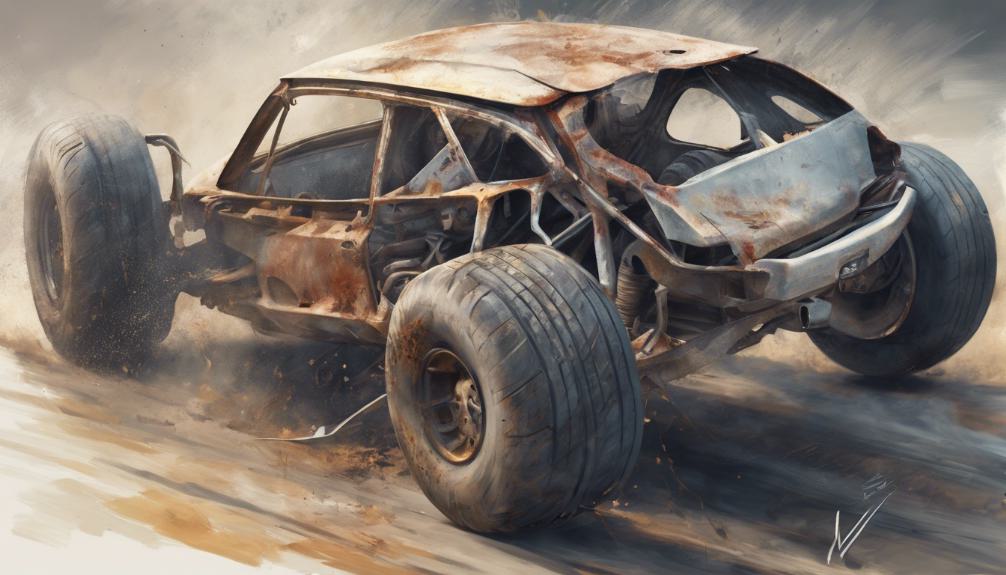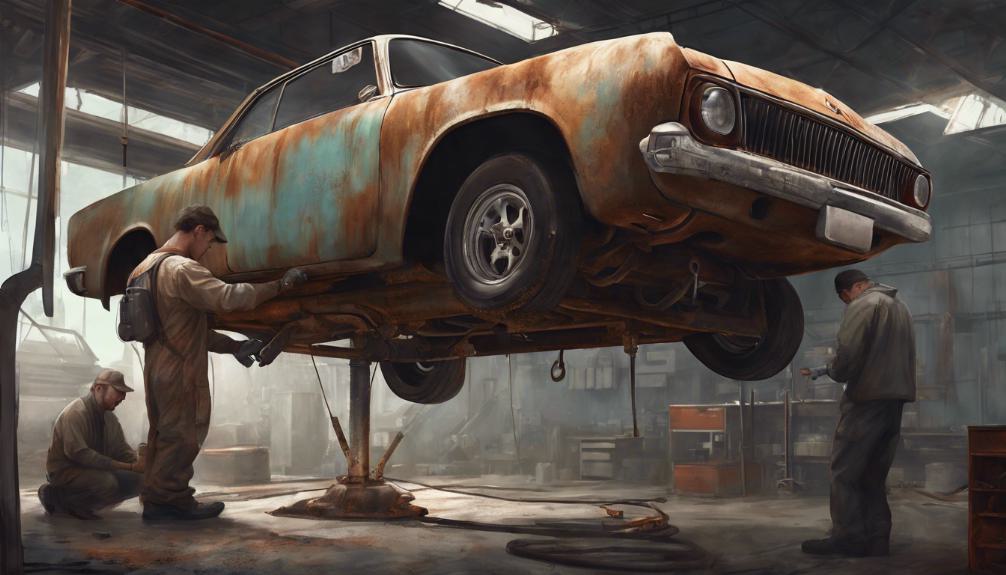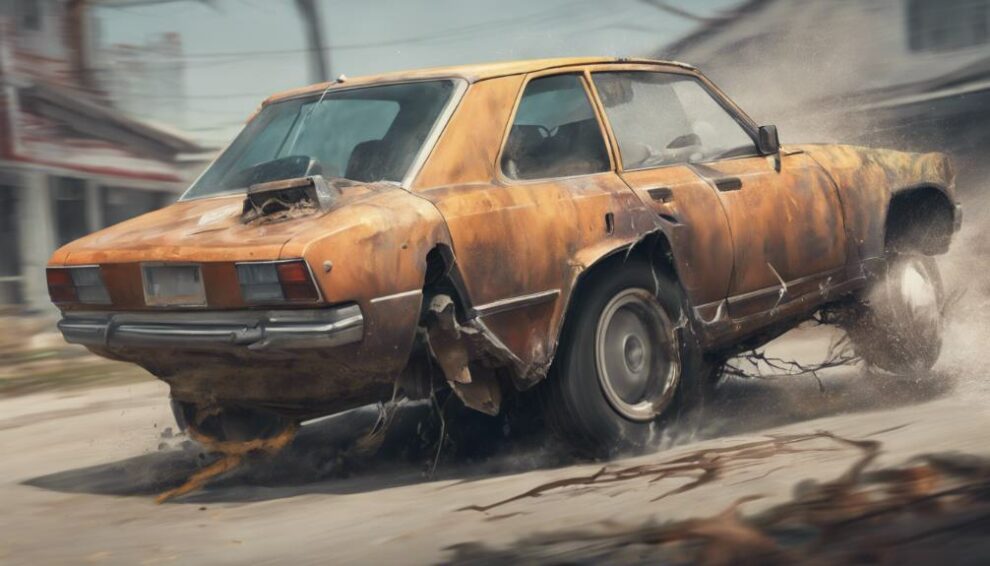If you detect excessive noise, vibration, uneven tire wear, or handling and suspension issues, your trailing arm may need attention.
The trailing arm plays an important role in rear axle movement control. Damaged bushings can amplify noise and vibration, therefore inspect for wear or damage. Swap out worn bushings to restore functionality and lessen noise.
Trailing arm problems can affect your vehicle’s handling and stability, impacting steering control and road grip. Look out for rust, cracks, and deformations on the trailing arm.
Remember, addressing these signs promptly will guarantee a safer and smoother driving experience.
What You Need to Know
- Excessive vibration and noise from the rear indicate trailing arm issues, check for worn bushings.
- Uneven tire wear may signal trailing arm or suspension problems, address promptly to prevent safety risks.
- Handling and stability issues like compromised steering control can result from damaged trailing arms.
- Suspension misalignment and steering problems can arise from faulty trailing arms, necessitating alignment adjustments.
- Conduct visual inspections for rust, cracks, wear on bushings, and other signs of trailing arm damage.
Excessive Vibration and Noise

If you’re experiencing excessive vibration and noise coming from the rear of your vehicle, it could be a warning sign that your trailing arm needs attention.
The trailing arm is an important component of your vehicle’s suspension system, responsible for controlling the movement of the rear axle.
One common issue that can lead to these symptoms is worn trailing arm bushings. These bushings act as a cushion between the trailing arm and the chassis, helping to absorb shocks and vibrations.
Over time, they can wear out, causing increased noise and vibration.
To address this problem, you may consider inspecting the trailing arm bushings for signs of wear or damage.
If they appear worn, replacing them with new bushings can help restore proper functionality and reduce noise.
Also, exploring dampening solutions, such as installing upgraded bushings or adding specialized dampening materials, can further improve the performance of your trailing arm and minimize vibrations.
Proper maintenance and timely replacement of trailing arm components are essential to ensure a smooth and comfortable driving experience.
Uneven Tire Wear
Uneven tire wear serves as an important indicator of potential trailing arm alignment or suspension component issues. Excessive inner or outer tire wear is a common sign of problems with the trailing arm.
If you notice uneven tire wear, it’s essential to address it promptly as it can lead to reduced tire lifespan and compromise your vehicle’s safety.
Monitoring tire wear patterns can help you identify trailing arm issues early on for timely intervention.
To tackle uneven tire wear, consider scheduling regular tire rotations and wheel alignments. Tire rotation helps promote even tire wear, extending the life of your tires and potentially reducing the strain on the trailing arm.
Wheel alignment ensures that your tires make proper contact with the road, preventing uneven wear patterns that could signal underlying trailing arm misalignment.
Handling and Stability Issues

Trailing arm issues can significantly impact your vehicle’s handling and stability on the road.
Problems with the trailing arm can compromise your steering control, making it challenging to navigate corners or sudden turns.
Also, a damaged trailing arm can affect your vehicle’s road grip, leading to instability, especially when driving over bumps or uneven terrain.
This instability can result in a loss of control, putting you and your passengers at risk.
Furthermore, handling issues related to a faulty trailing arm can impact your vehicle’s ability to maintain traction on the road, making it harder to drive safely, especially in adverse weather conditions.
If you notice any changes in how your vehicle handles or experiences a decrease in stability while driving, it’s important to address these issues promptly.
By taking action early, you can prevent further damage to your suspension system and ensure a smoother, safer driving experience for you and your passengers.
Suspension Misalignment
Inspect your vehicle’s suspension system for signs of misalignment. Misalignment can be caused by a faulty trailing arm.
Suspension misalignment from a bad trailing arm can lead to steering issues.
If your vehicle experiences alignment problems like drifting or constant steering correction, it may indicate misalignment due to trailing arm issues.
This misalignment can affect how your vehicle handles and its overall stability on the road. Misalignment from a faulty trailing arm can also cause uneven tire wear, further impacting alignment.
To address this issue, a professional may need to perform an alignment adjustment to correct the suspension geometry.
Regular visual inspections for rust, cracks, and worn components can help identify suspension misalignment early, preventing further damage.
Promptly addressing trailing arm problems is essential for safe driving conditions and preventing additional misalignment that could compromise your vehicle’s performance.
Visual Inspection

During a visual inspection of your vehicle’s suspension system, be sure to carefully examine the trailing arm for rust, cracks, or worn components. Here are some key points to keep in mind during this inspection:
- Corrosion Prevention: Look for any signs of rust or corrosion on the surface of the trailing arm. Corrosion can weaken the arm over time, compromising its structural integrity and overall performance.
- Structural Integrity: Inspect the trailing arm for any cracks or deformations that may indicate structural damage. Any compromise in the arm’s structure can lead to safety hazards and affect the vehicle’s handling.
- Bushings and Mounting Points: Check for visible signs of wear or stress on the bushings and mounting points where the trailing arm connects to other components.
Excessive wear in these areas can impact the arm’s functionality.
- Shock Absorber or Strut: Look for any signs of leakage or damage on the shock absorber or strut attached to the trailing arm. Issues with these components can affect the overall performance of the suspension system.
As an Amazon Associate we earn from qualifying purchases.










